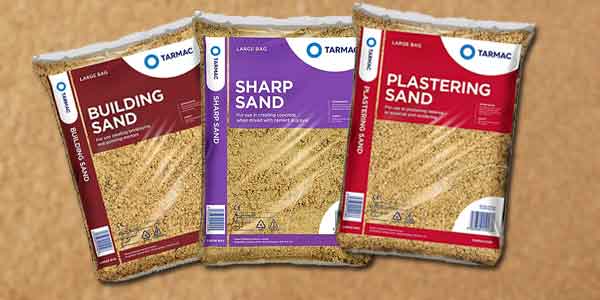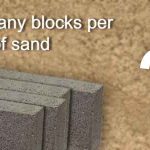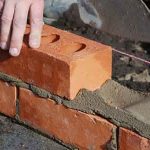Mixing good mortar is an important job in construction. For bricks and blocks to bond correctly, the right blend of ingredients is needed. If one part of the mix is incorrect, then it simply will not do its job. This could mean it is too thick, or too wet, and that will result in a weak bond.
Mortar that is mixed incorrectly will become unreliable; it could even become dangerous, as structures could fail. This means that it’s important to use the right sand. Sand acts as the glue and makes mortar more binding when mixed with cement and water. But there are many different types of sand available, which include:
- Builders’ sand
- Sharp sand
- Plastering or rendering sand.
- And even artificial sands
But which sand can be used in mortar?
It’s possible to use different types of sand when mixing mortar. The type of mortar you make will depend on the job and the finish. The range of sands consist of varying grains and impurities. Therefore, you use different types of sands for different jobs.
The most important part of mixing mortar, is to ensure you have the right blend. Therefore, it is crucial to use the right type of sand and the right amount, this will create a good mix, which will deliver the required bond.
What is General Builders Sand?

When mixing mortar, sand is an essential component. At the initial construction stage, high-quality building sand is crucial.
This is the most popular choice of sand when it comes to bricklaying. It is a soft sand, but when mixed with cement and water it creates a perfect mix. This helps to bond bricks and blocks together. It can be found in a range of colours, such as yellow, orange, brown and red.
It is used because it has a small grittiness that makes it flexible, provides a smooth finish and is essential for jobs where precision is crucial.
In general, builders’ sand is usually collected from riverbeds and riverbanks. It also has a small amount of salt and organic matter. This is important, as it helps to reduce the absorption of moisture. Excess moisture could cause damp problems and even weaken the mortar over time.
When mixing mortar using building sand, the mix can vary slightly based on how soft the masonry is. However, for bricklaying a common mix would be:
- 4 parts builder’s sand
- 1 part cement
- Water
- Plasticiser
Can You Use Sharp Sand For Bricklaying?
Sharp sand gets its name from its texture. This is because the particles in it are relatively large when compared with builders’ sand. The grains are also sharp and angular in shape.
This sand is often used when making concrete, because of the shape of the grains. As a result, it binds very well, but also delivers a tough finish and hard surface. Therefore, when it comes to bricklaying, sharp sand is often not the sand of choice.
When laying bricks, the mortar needs to be relatively flexible and pliable. This enables bricklayers to lay bricks and adjust them easily. This is the reason bricklayers prefer to use soft sand.
Sharp sand has less gradation, but it makes a stronger mortar, so you would assume that bricklayers would use it. However, sharp sand makes a mortar that is difficult to handle and making adjustments can prove challenging.
An important consideration to make, is the way in which buildings move naturally. Using sharp sand in mortar would increase the risk of cracking as the structure settles, because of the overall strength of the mortar.
While it is not recommended to use sharp sand in bricklaying, it is possible to use it depending on the job. However, you should make sure that it has less than 4% silt, as this will help to aid drainage and it will also help to reduce erosion.
Can You Use Plastering Sand for Bricklaying?
Plastering sand is washed to remove salt and clay content. This helps to prevent shrinking and cracking. However, it has a consistency that is much like builder’s sand. It has small grains that are smooth and that helps to achieve a smooth finish.
Again, this is sand that is found in riverbeds, but it is also washed to remove impurities. The reason for this, is so it can provide the right finish for render and plaster – hence the name (it is also known as rendering sand).
As it has the same consistency as builders sand, plastering sand can make a very usable and reliable mortar when it is mixed with cement and water.
Can You Use Artificial Sand for Bricklaying?
Artificial sand is another type that is sometimes used. As the name suggests, it is not naturally sourced, but is made artificially.
When compared with builders’ sand, it is very similar in consistency and grain. However, it is not widely used, because builders sand tends to be the most popular choice.
This sand is made by crushing basalt rock or granite rock and can have a greyish colour. It is sometimes used in place of builder’s sand due to short supply. This is because, it has the same consistency, with grains of a similar shape and size. Therefore, it is possible to use this in brick and block laying.
Conclusion
Bricklayers will always focus on the mortar that they use. This is because it will determine the overall finish, quality, and durability of their work. But the right mortar will need the right sand and in bricklaying, builders’ sand is most used.
While it is possible to use other sands, such as plastering sand or even artificial sand, bricklayers will prefer using builders’ sand, as it creates a mortar that is pliable, flexible and fit for purpose.




